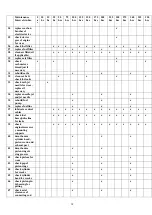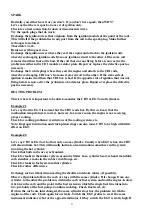
30
TROUBLESHOOTING
This section will discuss some of the most common problems encountered.
This section is not to be interpreted as a complete guide in which to troubleshoot a problem,
as there are many possibilities, additional points, areas and circumstances to be considered.
The following is described only in order to demonstrate the general way in which to go about
determining a problem.
As this type of troubleshooting can be complicated, and in respect to the possibility of
detrimental effect of making such adjustments and changes. These type of procedures are to
be completed only by an experienced mechanic knowledgeable and capable of making proper
judgements concerning the Hirth engine such as an authorized Hirth service technician.
As the function of one part of the system is affecting many other interrelated parts to some
degree and has a very complex chain reaction affect within the system, it may be foolish to
attempt to determine a problem on your own.
The Hirth engine is actually very simple in its design. It basically requires two necessities to
run. Spark and fuel/air mixture. The majority of problems are usually lack of spark, or lack
or abundance of fuel and/or air. Spark or lack of, is usually quite simple to determine. The
fuel/air mixture is a little more complicated. It must be determined whether it is a lack or
abundance of fuel in relation to the amount of air and at which point to make an adjustment.
The way to determine most problems, is thorough a process of elimination thorough isolating
the problem. Always start at the most likely and easiest point to check.
Never try more than one thing at a time, otherwise it will not be known as to which the cause
was and therefore difficult to determine which steps are necessary in order for it to be
prevented in the future.
If some of the more simple checks fail to determine the cause of a problem it will be necessary
to look more in depth at the situation.
If something is happening on one cylinder and not on the other, it may help to interchange
certain parts, in order to see if the problem moves to the other cylinder.
Note: Some parts are not to be interchanged.
It is important to monitor the exhaust gas temperature and the cylinder head temperature on
each cylinder in order to aid in finding the problem.
We will say that the engine we are working on is a twin cylinder, dual ignition engine with 2
carburetors.
Содержание F-23
Страница 17: ...17 Note 1 inch 25 4 millimeters ...
Страница 23: ...23 ...





































